Today’s Current Affairs: 23rd Feb 2024 for UPSC IAS exams, State PSC exams, SSC CGL, State SSC, RRB, Railways, Banking Exam & IBPS, etc
Table of Contents
Rani Chennamma:
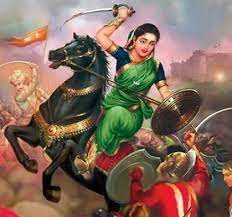
Commemorating the 200th anniversary of Rani Chennamma’s rebellion, social groups across India are organizing a national campaign called “Naanoo Rani Chennamma” (I am Rani Chennamma too).
- This campaign aims to empower women to fight against patriarchal, anti-democratic, and casteist forces in the country, drawing inspiration from Rani Chennamma’s legacy of courage and resistance.
- Rani Chennamma the Queen of Kittur, led the Kittur revolt of 1824, one of the earliest woman-led anti-colonial struggles against British rule in India.
- Born in 1778 in present-day Karnataka, she married Raja Mallasarja of Kittur and played a crucial role in defending her kingdom after his death.
- When the British refused to recognize her adopted son as the successor under the ‘doctrine of lapse’, she led a rebellion against them.
- Despite initial success, the British eventually captured Kittur Fort in December 1824, leading to Rani Chennamma’s imprisonment and subsequent death in 1829. ‘
- Her bravery and leadership in resisting colonial oppression have made her a symbol of Karnataka’s political imagination and a significant figure in Indian history.
Sammakka Saralamma Jathara or Medaram Jathara:
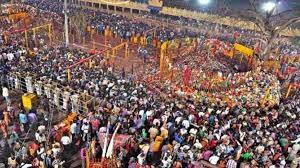
The Prime Minister of India extended greetings at the start of the largest tribal festival, Sammakka Saralamma Jathara or Medaram Jathara
- Medaram Jathara (primarily celebrated by the Koya tribe) is the largest tribal religious congregation in the world, held biennually, with approximately 10 million people converging on the place, over four days in the month of ‘Magha’ (February) on the full moon day in Medaram.
- Medaram is a remote place in the Eturnagaram Wildlife Sanctuary, Telangana.
- Medaram Jathara commemorates the bravery of Sammakka and Saralamma, tribal goddesses who fought against injustice.
- It is a festival with no Vedic or Brahmanic influence.
- Sammakka, found as a newborn amidst tigers, grew up to become a tribal chief and married Pagididda Raju (Kakatiya feudatory chief), she had two daughters, Sarakka and Nagulamma, and a son named Jampanna.
- During the Jathara people offer bangaram (gold) in the form of jaggery of a quantity equal to their weight to the goddesses and take holy baths in the Jampanna Vagu (stream).
- Jampanna Vagu, a tributary of River Godavari, named after tribal warrior Jampanna, runs red with his blood from battle against the Kakatiya Army. Tribals bathe here to honour his sacrifice and gain courage.
Sustainable & Inclusive Development Of Natural Rubber Sector (SIDNRS) Scheme:

The financial assistance for the Rubber sector under the ‘Sustainable & Inclusive Development of Natural Rubber Sector (SIDNRS)’ has been increased by 23% from Rs 576.41 crore to Rs 708.69 crore for the next 2 financial years (2024-25 and 2025-26).
- The government has also announced plans to set up three nodal Rubber Training Institutes in the Northeast to promote the development of rubber-based industries in the region.
- It will also promote the formation of Rubber Producers Societies (RPS) for the empowerment of rubber growers.
- Sustainable & Inclusive Development of Natural Rubber Sector (SIDNRS) Scheme is an initiative by the Government of India to promote the sustainable and inclusive development of the natural rubber sector in India.
- The SIDNRS scheme was launched in the FY 2017-18.
- It is implemented by the Rubber Board, a statutory body under the Ministry of Commerce and Industry.
- Objectives of the Scheme is to improve the productivity and quality of natural rubber production.
Annual NeSDA Way Forward Report 2023:

The Department of Administrative Reforms and Public Grievances (DARPG) has released the ‘Annual NeSDA Way Forward Report 2023’, showing that Jammu & Kashmir dominated with 1,117 e-services mapped on the NeSDA Way Forward Dashboard.
- The report is based on the National e-Governance Service Delivery Assessment (NeSDA) Framework.
- This framework serves as a benchmarking exercise to assess states/Union Territories and Central Ministries regarding their delivery of e-services.
Key Highlights of the Annual NeSDA Way Forward Report 2023:
- By the end of December 2023, a total of 16,487 e-Services were mapped on the NeSDA Way Forward Dashboard, showcasing the extent of digital service delivery across various sectors.
- In e-service delivery, Jammu & Kashmir is followed by Tamil Nadu (1,101 e-services), Madhya Pradesh (1010), and Kerala (911).
- Apart from Manipur, the bottom four states are Lakshadweep (42), Ladakh (46), Sikkim (51) and Nagaland (64).
- Jammu & Kashmir’s commendable progress in e-governance, as evidenced by the provision of 1120 e-services and achieving 100 % service delivery through their unified e-UNNAT (Unified, Integrated, Accessible, and Transparent) platform, has served as a source for replication and dissemination of e-services in Manipur.
- Across States/UTs 16,487 Total e-services are provided across States/UTs Jammu and Kashmir provides the maximum (1117) number of e-services, across States/UTs.
- Maximum e-services are provided in the sector – Local Governance & Utility Services .
- The tourism sector has achieved the highest saturation for the provision of all mandatory e-services in 23 out of 36 States/UTs.
- This is followed by Environment and Labour & Employment sector in 20 out of 36 States/UTs
- Rise in saturation of Mandatory e-Services from 48% in NeSDA 2019 to 69% in NeSDA 2021 to 76% in NeSDA Way Forward (2023).
- There are disparities among states, with Manipur facing challenges in providing e-services compared to other regions, indicating a need for concerted efforts to improve digital governance in lagging states.
Paruveta Festival:
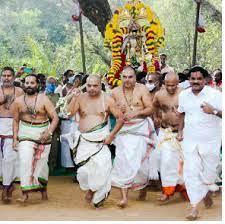
The Indian National Trust for Art and Cultural Heritage (INTACH) is making efforts to secure UNESCO recognition for the annual ‘Paruveta’ festival.
- The festival, also known as the ‘mock hunting festival’, is celebrated at the Sri Narasimha Swamy temple in the town of Ahobilam, Andhra Pradesh.
- It is celebrated by all sections of people, irrespective of their caste.
- It is a festival of communal harmony, as devotees from other religious communities like Muslims also offer prayers to the
- According to folklore, Lord Vishnu, upon his incarnation as a man-lion (Narasimha) in Ahobilam, married Maha Lakshmi, born as a tribal girl Chenchulakshmi.
- The Kurnool District Gazetteers, published by Government Press in 1881, record several beliefs of the Chenchu tribes, including their reverence for Ahobila Narasimha as their brother-in-law and inviting him home for Makar Sankranti.
- While Paruveta rituals are commonly observed in many temples during Vijayadashami or Sankranti, at Ahobilam, it is conducted for a ‘mandala’ (forty days).
Smishing : Threat

In today’s digital age poses a real and growing threat.
- Smishing is a form of phishing that targets individuals through text messages or SMS.
- It is just like phishing emails, smishing messages aim to trick you into divulging personal information or downloading malware onto your device.
- It is done in through Scammers send texts pretending to be from legitimate institutions like banks, government agencies, or delivery services.
- They’ll claim there’s a problem with your account or a package delivery, prompting you to click on a link for more information.
- Smishers play on your emotions by creating a sense of urgency.
- They might promise prizes, warn of impending legal action, or claim your account is compromised, pressuring you to act quickly without thinking.
- During tax season, scammers might pose as the income tax officers, offering tax refunds or threatening penalties if you don’t respond immediately.
- Similarly, they might capitalise on natural disasters or health crises to solicit donations or spread misinformation.
Rashtriya Udyamita Vikas Pariyojana:
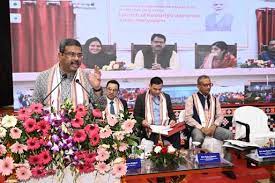
The Union Minister of Education and Skill Development & Entrepreneurship inaugurated the Rashtriya Udyamita Vikas Pariyojana, in Sambalpur, Odisha.
- Rashtriya Udyamita Vikas Pariyojana is tailored specifically for beneficiaries of the PM SVANidhi scheme, this unique National Entrepreneurship Development Project underscores the government’s steadfast commitment to nurturing job providers across the nation.
- It aims to equip individuals with comprehensive entrepreneurship training, creating job providers rather than job seekers.
- This initiative focuses on reskilling and upskilling employees to enhance their competitiveness and adaptability in an era of disruptive technology.
- It will offer comprehensive entrepreneurship training over a period of 22 weeks, combining theoretical knowledge with practical exposure through experiential learning.
- The training will be conducted through offline, online and hybrid modes, with certificates awarded upon completion, enhancing the course’s credibility and value.
- The Government of India has partnered with Flipkart to skill street vendors and small shopkeepers.
- Under the pilot program, street vendors in 10 big cities of the country will be given a stipend along with training to expand their businesses.
Flood Management And Border Areas Programme:
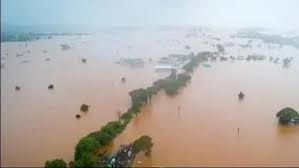
The Union Cabinet approved the proposal of Department of Water Resources, RD & GR for the continuation of “Flood Management and Border Areas Programme (FMBAP)” with a total outlay of Rs. 4,100 crores for a period of 5 years from 2021-22 to 2025-26
- Flood Management and Border Areas Programme is a centrally sponsored Scheme.
- The Scheme has two components:
- Flood Management Programme (FMP) component: In this central assistance will be provided to State Governments for taking up critical works related to flood control, anti-erosion, drainage development and anti-sea erosion, etc.
- River Management and Border Areas (RMBA) component: Under this flood control and anti-erosion works on common border rivers with neighbouring countries including hydrological observations and flood forecasting, and investigation & pre-construction activities of joint water resources projects (with neighbouring countries) on common border rivers will be taken up with 100% central assistance.
- Funding: The pattern of funding to be followed is 90% (Centre): 10% (State) for Special Category States (8 North-Eastern States and Hilly States of Himachal Pradesh, Uttarakhand and UT of Jammu & Kashmir) and 60% (Centre): 40% (State) for General/ Non-Special Category States.
- The works implemented under the RMBA component also protect important installations of security agencies, border outposts, etc. along the border rivers from flood and erosion.
- The Scheme has the provision of incentivizing the States which implement flood plain zoning, recognized as an effective non-structural measure for flood management.




